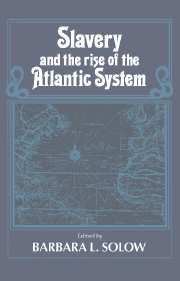Book contents
- Frontmatter
- Contents
- Preface
- List of contributors
- Introduction
- 1 Slavery and colonization
- 2 The Old World background of slavery in the Americas
- 3 Slavery and lagging capitalism in the Spanish and Portuguese American empires, 1492–1713
- 4 The Dutch and the making of the second Atlantic system
- 5 Precolonial western Africa and the Atlantic economy
- 6 A marginal institution on the margin of the Atlantic system: The Portuguese southern Atlantic slave trade in the eighteenth century
- 7 The apprenticeship of colonization
- 8 Exports and the growth of the British economy from the Glorious Revolution to the Peace of Amiens
- 9 The slave and colonial trade in France just before the Revolution
- 10 Slavery, trade, and economic growth in eighteenth-century New England
- 11 Economic aspects of the growth of slavery in the seventeenth-century Chesapeake
- 12 Credit in the slave trade and plantation economies
- Index
12 - Credit in the slave trade and plantation economies
Published online by Cambridge University Press: 20 October 2009
- Frontmatter
- Contents
- Preface
- List of contributors
- Introduction
- 1 Slavery and colonization
- 2 The Old World background of slavery in the Americas
- 3 Slavery and lagging capitalism in the Spanish and Portuguese American empires, 1492–1713
- 4 The Dutch and the making of the second Atlantic system
- 5 Precolonial western Africa and the Atlantic economy
- 6 A marginal institution on the margin of the Atlantic system: The Portuguese southern Atlantic slave trade in the eighteenth century
- 7 The apprenticeship of colonization
- 8 Exports and the growth of the British economy from the Glorious Revolution to the Peace of Amiens
- 9 The slave and colonial trade in France just before the Revolution
- 10 Slavery, trade, and economic growth in eighteenth-century New England
- 11 Economic aspects of the growth of slavery in the seventeenth-century Chesapeake
- 12 Credit in the slave trade and plantation economies
- Index
Summary
A few years ago, I was invited to prepare for this conference a paper on credit in the slave trade. Over the years, I had accumulated some scraps of data on this topic, as well as bibliographic references to the vast and ever-growing library of scholarly books on slavery. After accepting this deceptively easy assignment, I proceeded through a very long shelf of publications on the slave trade – including many by those here today – only to discover that most of these erudite works had relatively little to say about credit. Thus, of necessity, this chapter is not a rich synthesis of existing scholarship but an exploratory essay suggesting some questions and answers hinted at by our still scrappy evidence.
We can perhaps usefully start with a generalized if simplified way of thinking about the problem of credit in the slave trade and slave economies. In the seventeenth and eighteenth centuries the dynamic areas of the slave economies, the principal destinations of the slave trade, were in most cases what can be described from a European perspective as initially frontier areas, underpopulated territories of new settlement. In such areas, land is characteristically abundant and cheap, whereas capital and labor are scarce and, by European standards, expensive. Such almost valueless land can be made productive and valuable – a process succinctly expressed is the French phrase mettre en valeur – only by the application of capital and labor.
- Type
- Chapter
- Information
- Slavery and the Rise of the Atlantic System , pp. 293 - 340Publisher: Cambridge University PressPrint publication year: 1991
- 15
- Cited by



